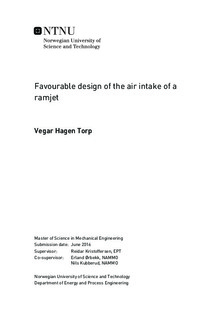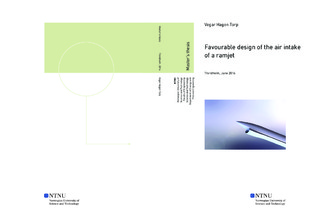| dc.description.abstract | Up until recent years, the guidance systems of missiles have been the limiting factor for the range of air-to-air missiles. However, with recent developments in electronics and computer technology allowing targeting of objects outside the line of sight of the launch vehicle, the propulsion system have become the larger limitation.
The source of oxidizer holds the greatest potential for improvement in this regard. Conventional missiles use rocket engines carrying the oxidizer with them (solid-fuel rocket engines), which takes up valuable space and adds weight to the missile. By implementing a ramjet engine instead, the weight can be reduced by almost 90 \%.
A ramjet-engine on a missile is, however, associated with a number of other difficulties. For example, the mass flow of air delivered by an intake at supersonic speeds does not automatically adjust to the air disposed by the nozzle, as is the case in subsonic flight. If for example the engine requires more air than the intake can supply, the intake cannot capture any more air than what is incident on the intake. If the opposite is the case, i.e. the intake delivers more air than the engine requires, air will be spilled around the intake increasing drag and the risk of unsteady flow phenomena. In aircraft this problem is often solved by implementing adjustable intake- and nozzle-geometry, so that the supply and demand are always matched. For missiles however this is generally avoided in order to ensure cost-efficiency. Weight, drag and performance during manoeuvres are also important considerations to be made in the design of the propulsion system. Together, these factors make the design of the air intake of primary concern for the successful operation of a ramjet powered missile.
This report investigates important factors that should be considered in the design of a RAM-jet air intake. A design based on this study is proposed and tested by means of computational fluid dynamics.
Of particular interest in regard to the performance of an intake, are the characteristics of total pressure recovery and mass flow rate vs. Mach number, angle of attack and sideslip. These will be found through a combination of axisymmetric and 3D-simulations with eddy viscosity models in ANSYS Fluent. | |

